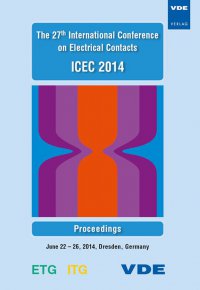The electrical contact resistance endurance of heterogeneous Ag/Sn interfaces subjected to fretting wear
Konferenz: ICEC 2014 - The 27th International Conference on Electrical Contacts
22.06.2014 - 26.06.2014 in Dresden, Deutschland
Tagungsband: ICEC 2014
Seiten: 6Sprache: EnglischTyp: PDF
Persönliche VDE-Mitglieder erhalten auf diesen Artikel 10% Rabatt
Autoren:
Perrinet, O.; Laporte, J.; Fouvry, S. (LTDS, CNRS UMR 5513, Ecole Centrale de Lyon, 36 Avenue Guy de Collongue, 69134 Ecully Cedex, France)
Alquier, O. (PSA - Centre Technique, Vélizy - Villacoublay, France)
Inhalt:
The main requirement for materials used in electrical connectors is to allow low and stable electrical contact resistance (ECR) endurance [1-3]. However, due to engine vibration, fretting wear damage can occur in the interface, reducing the electrical conductivity. When fretting sliding is small (low vibration situation), low-cost Sn/Sn coating interfaces can be applied. By contrast, when larger fretting sliding induced by severe vibration conditions is activated, expensive noble interfaces such as Ag/Ag must be used. In many situations, vibration conditions are intermediate, which may allow application of heterogeneous noble/non-noble interfaces. The objective of this research is to clarify this aspect by comparing ECR endurance evolution versus fretting sliding amplitude (i.e., Nc fretting cycles when DeltaR>DeltaRth=4mOmega) of homogeneous Sn(2micrometer)/Sn(2micrometer) and Ag(2micrometer)/Ag(2micrometer) and also heterogeneous Ag(2micrometer)/Sn(2micrometer) interfaces. As expected, the ECR endurance of the noble Ag/Ag interface was significantly greater than for the non-noble Sn/Sn contact: ECR failure of the noble Ag/Ag contact was related to the slow elimination of silver from the fretting interface, whereas ECR failure of the non-noble Sn/Sn contact was related to the fast formation of an insulating Sn oxide debris layer. The Sn/Ag ECR endurance response was between the two homogeneous evolutions, but closer to that of the non-noble Sn/Sn interface. A complete fretting wear analysis suggested that the Sn/Ag interface was still controlled by the total elimination of silver from the fretting contact, but the presence of the Sn layer, by favoring the formation of abrasive Sn oxides, sharply increased the wear rate of the Ag coating.


